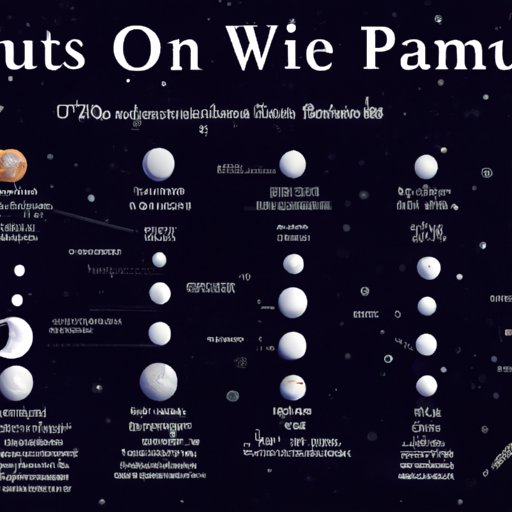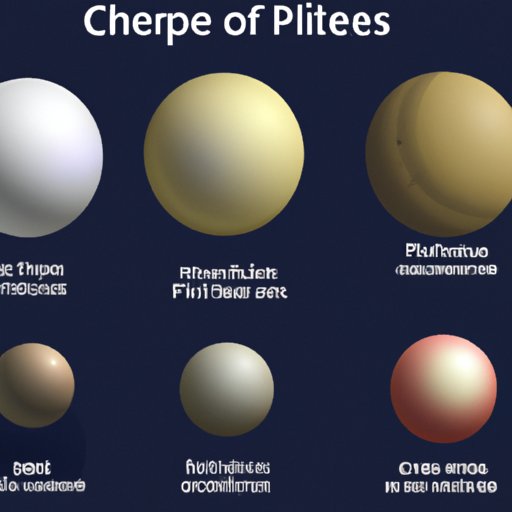Introduction
When we talk about the planets in our solar system, we often think of the eight large celestial bodies orbiting the sun. But did you know there are also dwarf planets in our cosmic neighborhood? These small, icy worlds are fascinating in their own right, and scientists are still discovering more of them. In this article, we will take a look at the dwarf planets in our solar system, their characteristics, and their significance.
Exploring the Dwarf Planets of our Solar System: How Many are There?
Before we dive into the specifics of each dwarf planet, let’s start with the basics. What exactly is a dwarf planet? A dwarf planet is a celestial body that orbits the sun and is large enough to have a roughly spherical shape, but has not cleared the area of its orbit of other debris.
The discovery of dwarf planets is a relatively new phenomenon. Before 2006, Pluto was considered the ninth planet in our solar system. However, in that year, the International Astronomical Union (IAU) redefined what constitutes a planet. This reclassification resulted in Pluto being demoted to a dwarf planet, alongside several other celestial bodies.
So how many dwarf planets are there in our solar system? As of now, there are five officially recognized dwarf planets: Pluto, Ceres, Eris, Makemake, and Haumea.

A Guide to the Dwarf Planets: Counting the Small Celestial Bodies in our Solar System
Let’s take a closer look at each of the five recognized dwarf planets in our solar system:
1. Pluto
Pluto is the most famous of the dwarf planets, and for good reason. It was the first dwarf planet to be discovered – in 1930, by astronomer Clyde Tombaugh. Pluto is located in the Kuiper Belt, a region beyond Neptune that is full of icy objects. Pluto is relatively small – it is only about 1/6th the size of Earth – and has a highly eccentric orbit that takes it closer to the sun than Neptune at times.
2. Ceres
Ceres is the largest object in the asteroid belt, a region between Mars and Jupiter that is full of rocky debris. It was the first asteroid to be discovered – in 1801, by astronomer Giuseppe Piazzi. In 2015, NASA’s Dawn spacecraft visited Ceres and found evidence of water ice on its surface.
3. Eris
Eris is located in the Kuiper Belt, like Pluto. It is about the same size as Pluto, and was actually the reason for the IAU’s reclassification of planets. Eris was discovered in 2005 by a team of astronomers led by Michael Brown.
4. Makemake
Makemake is located in the Kuiper Belt as well. It was discovered in 2005, shortly after Eris, by a team of astronomers at the Palomar Observatory in California. Makemake is named after the creation deity of the Rapa Nui people of Easter Island.
5. Haumea
Haumea is the most unusual of the dwarf planets. It is located in the Kuiper Belt, and is elongated in shape – it is about the same width as Pluto, but is three times as long. Haumea has two small moons, Hi’iaka and Namaka, and rotates incredibly quickly – it completes one rotation in just under four hours.
Unveiling the Dwarf Planets: Understanding the Latest Count and Classification
As mentioned earlier, the IAU redefined what constitutes a planet in 2006, resulting in the reclassification of Pluto and other objects as dwarf planets. So what are the criteria for a celestial body to be classified as a dwarf planet?
Firstly, the celestial body must be in orbit around the sun. It must also be large enough to have a roughly spherical shape. Finally, it must not have cleared the area of its orbit of other debris – in other words, it shares its orbit with other objects of a similar size.
The classification of Pluto as a dwarf planet has been controversial since it was first announced. Many people still consider Pluto to be a planet, and the decision to reclassify it remains a topic of debate in the scientific community.
Beyond Pluto: Discovering the Miniature Worlds in our Cosmic Neighborhood
While Pluto is easily the most well-known of the dwarf planets, there are many others beyond it in the Kuiper Belt and elsewhere in our solar system. Here are some of the more notable ones:
1. Sedna
Sedna is located in the Oort Cloud, a region beyond the Kuiper Belt that is thought to be the source of many long-period comets. Sedna is named after the Inuit goddess of the sea, and is one of the reddest objects in our solar system.
2. Orcus
Orcus is located in the Kuiper Belt and is roughly the same size as Pluto. It has a large moon, Vanth, and was named after the Etruscan god of the underworld.
3. Quaoar
Quaoar is located in the Kuiper Belt and is roughly 1,100 kilometers in diameter. It was discovered in 2002 by astronomers Chad Trujillo and Michael Brown. Quaoar is named after the creation deity of the Tongva people of the Los Angeles area.
Small but Mighty: Digging into the Dwarf Planets and Their Significance
So why study dwarf planets? Despite their small size and often remote locations, dwarf planets can tell us a lot about the formation and evolution of our solar system. They can also provide useful information about the conditions present in the outer solar system, and could potentially harbor life.
For example, the discovery of water ice on Ceres suggests that there could be water in many other parts of the solar system – even in areas that receive very little sunlight. This has implications for the search for life beyond Earth, as water is essential for life as we know it.
The Dwarf Planets: Tracking their Movements and Characteristics
Dwarf planets, like all celestial bodies, move in predictable ways in our solar system. They orbit the sun in elliptical paths, and their movements can affect their temperatures, surface features, and atmospheres.
Scientists use a variety of tools to study dwarf planets, including telescopes, spacecraft, and ground-based observatories. These tools allow us to learn more about the characteristics of dwarf planets, such as their composition, surface features, and atmospheres.
Piecing Together the Puzzle of Dwarf Planets: An Investigation into their Origins and Evolution
Finally, let’s take a look at how dwarf planets formed and evolved in our solar system. One theory is that they were leftover from the formation of the solar system, and were prevented from growing into full-sized planets by gravitational interactions with other objects. Another theory suggests that they formed much like larger planets, but were then disrupted by collisions with other objects.
Regardless of how they formed, the study of dwarf planets is an active area of research, and scientists are still uncovering new information about these small celestial bodies.
Conclusion
Dwarf planets may be small, but they have big implications for our understanding of our solar system and the wider universe. From the famous Pluto to the lesser-known Sedna, each dwarf planet has its own unique characteristics and story. By studying them, we can learn more about the formation and evolution of our cosmic neighborhood, and perhaps even discover signs of life beyond Earth.
If you’re interested in learning more about dwarf planets, there are many resources available online and at your local library.
